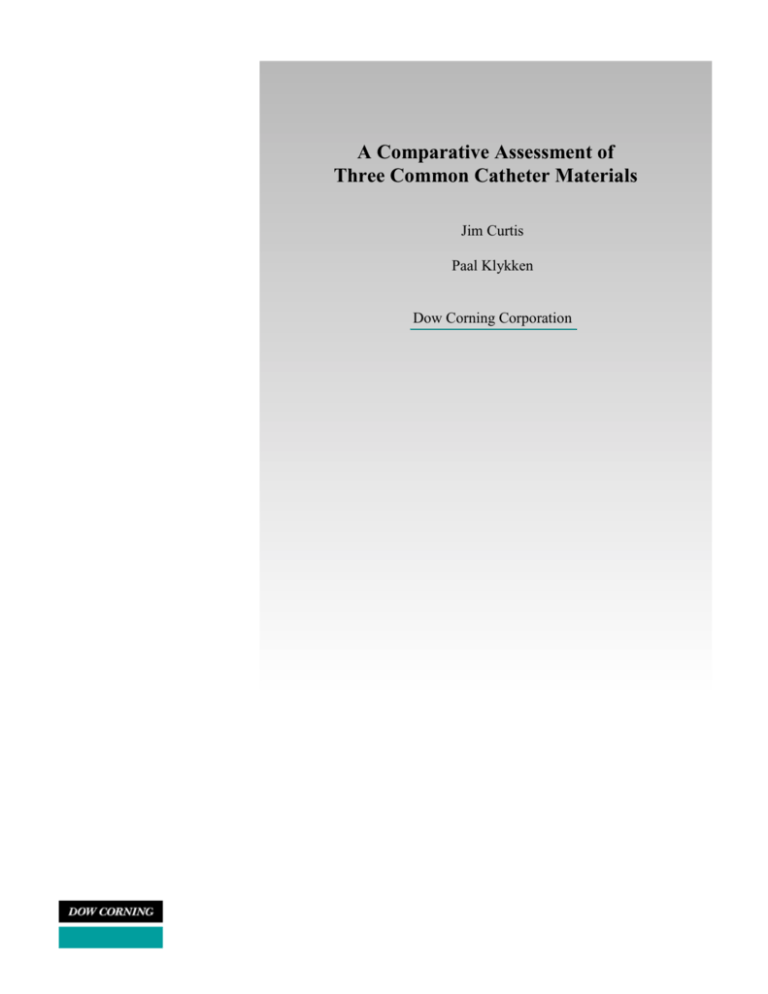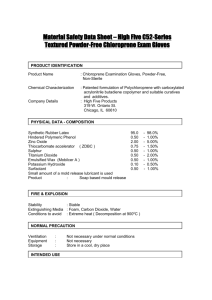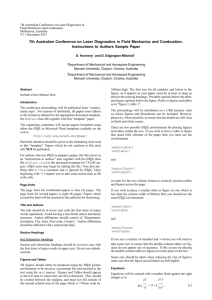
A Comparative Assessment of
Three Common Catheter Materials
Jim Curtis
Paal Klykken
Dow Corning Corporation
A Comparative Assessment of Three Common Catheter Materials
Catheters are medical devices, typically in the form of a tube, that are inserted into the body to
remove fluid, create an opening, or deliver a drug. The biocompatibility of catheters, as with
other medical devices, can be defined as the ability of the device to perform its intended function
without eliciting undesirable side effects. Biocompatibility will be dependent on physical
properties of the device (e.g., rigidity, surface smoothness) and its chemical nature; is it
allergenic, are there toxic leachables? Catheter biocompatibility is also dependent on whether
the body’s reaction to the device will affect its function. A relevant example is mineral salt
encrustation of urological catheters.
While there is no ideal catheter material, some are much more biocompatible than others. Their
biocompatibility is related not only to the basic polymers, but also to the various additives used.
What follows is an overview of the biocompatibility of three common catheter materials:
silicones, polyvinyl chloride (PVC), and latex rubber. The focus is on some of the principal
problems that have been encountered: allergies, phlebitis, encrustation, infection, and deflation.
Silicones
Silicones, one of the most thoroughly
tested and widely-used groups of
biomaterials, are well known for their
intrinsic biocompatibility and
biodurability. These key characteristics
have been attributed to the material’s
inherent chemical and thermal stability,
low surface tension and hydrophobicity.
As a result of these properties, silicones
have the benefit of extensive application
in catheters and other medical products.
Silicones have been successfully applied
in short- and long-dwelling catheters,
drains, and shunts for over sixty years.
They remain materials of choice in many
demanding applications.1
Silicone elastomer is a thermosetting
material, capable of being processed by
various molding, dipping, and extrusion
methods. Once cross-linked into the
desired configuration, silicone catheters
are thermally stable (reported operating
range from -80 °C to +230 °C),3
remaining essentially unaffected by
repeated autoclaving. They can usually
be dry-heat sterilized as well.
Composition of Silicones
Silicones are a group of synthetic polymers whose backbone
is comprised of repeating silicon to oxygen bonds. In
addition to their bonds with oxygen to form polymeric
chains, the silicon atoms are also bonded to organic groups,
typically methyl groups. This most common form of silicone
is known by the International Union of Pure and Applied
Chemistry (IUPAC) name polydimethylsiloxane, abbreviated
as PDMS.
CH3
CH3
H3C
Si
CH3
O
Si
CH3
CH3
O
Si
CH3
CH3
n
PDMS is a liquid of varying viscosities depending upon
chain length. PDMS polymers can be transformed into
three-dimensional elastomeric networks by way of catalyzed
cross-linking reactions, which create chemical bonds
between adjacent chains. Silicone elastomers used in
medical device applications normally include reinforcing
filler, typically fumed amorphous silica, which becomes
inextricably bound within the overall elastomeric network.
Incorporation of reinforcing filler into the cross-linked
matrix reduces material stickiness, increases hardness, and
enhances mechanical strength.2
2
Polyvinyl Chloride
Polyvinyl chloride is generally referred to by the abbreviation PVC and has the IUPAC name
polychloroethene. It is prepared by the addition polymerization of vinyl chloride monomer. A
chemical initiator is used to facilitate the reaction by opening the
H
double bond, thereby presenting another initiation site on the
opposite side of the monomer bond for continuing molecular
Cl
growth.4
PVC is thermoplastic, although the pure polymer is hard and stiff.5 The addition of chemicals
known as plasticizers is necessary to make PVC soft and flexible. These plasticizers, which can
comprise a third by mass of the compounded plastic,6 are not chemically bound in the polymer
molecules. As such, these additives can be extracted in vivo causing several problems:
induction of an acute inflammatory reaction to the leached plasticizer,7 increased polymer
stiffness/brittleness, and an increased failure rate due to breakage when compared to other
biomaterials.8
In 2002, the US FDA issued a Public Health Notification concerning PVC.9 The agency
expressed concerns regarding exposure to the PVC plasticizer DEHP (di(2-ethylhexyl)phthalate)
that is used in numerous medical devices including catheters, blood bags, and extracorporeal
tubing. Exposure to DEHP had produced a range of adverse effects in laboratory animals, most
notably liver toxicity and testicular atrophy.10 In view of the available animal data, the agency
advised, “precautions should be taken to limit the exposure of the developing male to DEHP.”9
In the wake of public health concerns regarding phthalate plasticizers, PVC is becoming an
outdated legacy material overtaken by others “better suited to the demands of healthcare
applications.”11
Latex Rubber
Latex rubber is the term often applied to the natural milkywhite thick colloidal suspension containing hydrocarbon
polymer and the articles made from it. Latex rubber is
most often obtained commercially from the sap of the Pará
rubber tree (Hevea brasiliensis), named for the Brazilian
state in which the plant was discovered.
The chemical composition of latex materials varies but is
generally as shown in Table 1.
Table 1:
Chemical Composition of Latex16
Percent
Component
55-65 Water
30-40 Cis-1,4-polyisoprene particles
2-3
Plant proteins
1.5-3.5 Resin
1.0-2.0 Sugars
0.5-1.0 Ash
0.1-0.5 Sterol glycosides
Primarily due to the human immunodeficiency virus (HIV)
pandemic, the use of latex gloves and condoms sharply increased in the 1980s. This increased
usage coincided with increased reports of latex allergies, especially among healthcare workers.
The prevalence of latex allergies among medical professionals has since been estimated to be
between 8 and 17%.13,14
Other populations are also at risk, such as spina bifida and spinal cord patients who have had
repeated or chronic exposure to latex catheters. Studies have reported the prevalence of latex
sensitivity in children with spina bifida ranging from 30 to 41%.15-17 In a study of incontinent
adult spinal cord injury patients, 47% had an allergic response to latex.18 The prevalence in the
general population is believed to be lower, ranging from 1 to 6%.13
3
For some people, contact with latex
products such as catheters can be life­
threatening.19,20 For example, deaths have
been attributed to anaphylaxis from latex
retention balloons used in barium enema
exams.21 Latex allergies usually present as
a Type I (IgE-mediated) immediate
allergic reaction to proteins contained in
the natural rubber. Powder lubricants such
as corn starch can bind with natural latex
proteins and thereby exacerbate
exposure.22 Aside from proteins, several
of the additives used during manufacture
have also been implicated as causal agents.
For example, remnant amounts of some of
the accelerators (e.g., carbamates,
thiurams, mercaptobenzo-thiazole) might
cause a Type IV (T-cell mediated) delayed
hypersensitivity reaction.14,23
Latex allergies are now regarded as a
major healthcare issue and many hospitals
have adopted risk management policies
restricting use of latex-containing products
in order to protect patients and healthcare
workers alike.19,20 The conversion of
medical facilities to “latex-safe” can
reduce employee sensitization,
impairment, and disability. Healthcare
facilities, regardless of size, are thereby
likely to benefit financially from becoming
latex-safe.24
Material Comparisons
Manufacture of Dipped Latex Rubber Medical Devices
After the milky fluid has been gathered from the tapped
trees, stabilizing ammonia-based preservatives are added to
discourage microbial spoilage. The latex is then
concentrated through centrifugation, evaporation, or a
process called creaming in which a chemical is added
causing the polymer particles to swell and rise to the
surface. Next, the material is compounded with additional
chemical additives such as accelerators (to help
vulcanization occur), surfactants (to prevent phase
separation) and antioxidants (to prevent degradation).
Medical devices, such as balloon catheters, condoms and
surgical gloves, are typically generated from latex using a
dip-molding process. Dipped goods account for more than
half of the latex used in the United States.25 A rigid tool
known as a mandrel is prepared of the proper shape and
size. The tool is pre-dipped into a solution of coagulant,
such as calcium nitrate. The mandrel is then immersed into
the vat containing the stabilized, concentrated, compounded
liquid latex material. The coagulant causes the milky latex
to gel and thereby coat the mandrel. The mandrel is then
slowly withdrawn from the liquid. Passage through an oven
(or heat zone) completes the coagulation process.
Additional dips into the vat can be used, if necessary, to
increase the coating thickness. Next the coated mandrels
are dipped into or sprayed with water to wash out some of
the coagulant and other additives.
The vulcanization step occurs next. As the coated mandrel
is heated, the vulcanizing agent (a sulfur-containing
compound) reacts with the isoprene polymers resulting in a
cross-linked rubber. After cooling, the cured rubber can be
removed from the mandrel. Typically the rubber articles are
again leeched in water in an attempt to remove remnant
sulfur and other additives.
A powder lubricant such as corn starch may be used to
prevent the latex products from adhering. In some cases,
surface treatments such as chlorination may be used as an
alternative to lubrication.12,25
Unlike latex, Dow Corning healthcare silicones contain no proteins and are non-allergenic.26-28
Unlike PVC, they contain no phthalates or other organic plasticizers which might leach out.
Silicone catheters29 and tubing30 appear to be less thrombogenic than standard PVC tubing and
catheters. In one study, an ex vivo shunt in a canine model was used to compare thrombogenic
response to two different standard reference materials: National Heart Lung and Blood Institute
primary reference material polydimethylsiloxane and IUPAC reference material polyvinyl
chloride. While leukocyte affinity and the fibrinogen adsorption rate were not significantly
different for the two reference materials, platelet affinity was significantly higher for the PVC.31
Phlebitis, an inflammation of the veins sometimes associated with thrombosis, can be caused by
mechanical trauma from insertion and movement of venous catheters. When silicone was
compared to PVC intravenous (IV) catheters for parenteral nutrition, a lower complication rate,
higher rates of IV therapy completion, and longer service life were demonstrated (Table 2).32
Consistent with these results, most modern central venous catheters intended for chronic use are
made of silicone elastomer.5
4
In another study that compared silicone and PVC catheters
for parenteral nutrition, the silicone catheters had
significantly less sepsis, prolonged service life (by 50%) and
fewer catheter insertions per patient.8
Premature infants are particularly predisposed to phlebitis.
One study compared the complications observed for silicone
catheters in premature babies with those associated with PVC
catheters. The researchers found that the silicone catheters
were better at maintaining their physical properties and
flexibility over time when compared to the PVC catheters.33
A common problem with urinary catheters
is mineral encrustation, which occurs
when urease-producing bacteria hydrolyze
urea to ammonia making the urine more
alkaline. The increased pH results in formation and precipitation of calciumand magnesium-containing crystals. This mineral deposition can block the
catheter eyelet and cause pain during extraction.34 Figure 1 shows a siliconecoated (A) and uncoated latex catheter (B). The silicone coating may help
reduce mineral encrustation on the tip or within the lumen of the catheter.35
An in vitro study compared four types of catheters
using human urine inoculated with the gramnegative anaerobic bacterium Proteus mirabilis
which has been associated with the formation of
uroliths (bladder stones). The mean time before
each catheter type became blocked was monitored.
Of the four test materials, the all-silicone and
silicone-coated catheters remained patent the
longest as shown in Figure 2.36
Figure 2: Patency Duration of Urinary Catheters
50
40
30
Hours
Figure 1
A
B
Table 2:
Catheters for Parenteral Nutrition32
Catheter Silicone PVC
Count
Catheters
43
40
Patients
40
40
Average number
23½
10¾
of days in use
Reasons for IV Catheter Removal
Therapy
25
5
Completion
Phlebitis
1
8
Thrombosis
0
4
Sepsis
0
6
Plugged
3
8
Death
10
9
Other
4
0
20
10
0
Silver-coated
Hydrogel-coated Silicone-coated
All-Silicone
In another study comparing 14-day indwelling
Latex
Latex
Latex
urinary catheters in elderly patients, formation of
encrustations and blockage was significantly less in patients with silicone catheters as compared
to Teflon®-coated latex or all-latex catheters.37 As noted by others, “Constructing catheters of
the best biomaterial to discourage biofilm formation, i.e., silicone elastomer, has been a great
advance.”5
Figure 3: Bacterial Migration Index
In addition to sub-clinical biofilm colonization,
clinically-evident infection is another possible
complication associated with catheter use. One
study found that Foley catheters made entirely of
silicone had less potential for bacterial migration
compared to latex catheters with various coatings,
including a silver-containing hydrogel, as shown in
Figure 3.38
60
50
40
30
20
10
0
Hydrogel-coated
Latex
5
Silver/Hydrogelcoated Latex
Silicone-coated
Latex
All Silicone
Another study used radio-labeled gram-negative bacilli to examine bacterial adherence to various
catheter materials. Adherence was found to be significantly less to siliconized rubber than to
pure latex.39
Besides encrustation and infection, another complication with balloon catheters is deflation.
Premature deflation can be a problem, regardless of where in the body the balloon is used.
Researchers compared latex and silicone embolization balloons in the treatment of varicocele, a
widening of the veins along the spermatic cord. The time until deflation was found to be
significantly longer for the silicone balloons, 9.9 months compared to 5.1 months for the latex.40
In addition to the main intended use for bladder drainage, the readily-available Foley catheter
finds application in unusual spots, for example, post-nasal packing. A comparison of silicone
and latex Foley catheters found 30% of the latex catheters failed, whereas the silicone type was
“100% reliable.”41
Economy of Using Silicone
Silicone catheter raw materials are more expensive than legacy materials such as latex and PVC,
but when examining healthcare choices other factors should be taken into account. For example,
consider infection. Urinary tract infections account for
PVC Disposal
over 40% of all nosocomial infections, and almost all
these infections are associated with indwelling catheters. Disposal of medical products made from
PVC can be problematic. The preferred
The acquisition of urinary tract infections following
biohazard waste disposal method for
urinary bladder catheterizations is associated with nearly
hospitals is often incineration.
a threefold increase in mortality among hospitalized
Incineration of used PVC medical
patients. An estimate of the economic impact indicates
devices such as catheters and tubing
generates hazardous gases including
that patients with hospital-acquired urinary tract
hydrochloric acid (HCl), dioxins, and
infections secondary to indwelling catheters, spend an
polychlorinated biphenyls (PCBs). In
average of 2.4 additional days in the hospital. Bearing
addition to the environmental impact of
this in mind, even a marginal decrease in urinary tract
such air population, the HCl shortens the infections may be cost-effective.42
life of the incinerator.43-46
In summary, catheters produced from silicone have been
reported to improve patient comfort and reduce total patient cost by reducing the: 1.
2.
3.
4.
5.
6.
7.
8.
Occurrence of allergic responses
Incidence of phlebitis
Frequency of sepsis
Number of catheter insertions
Likelihood of mineral encrustations
Potential for bacterial migration
Occurrence of premature balloon deflation
Potential for nosocomial infections
6
References
1. Curtis J and Colas A. Medical Applications of Silicones. In: Biomaterials Science: An Introduction to
Materials in Medicine. (Ratner BD et al., eds.) Second Edition. Elsevier Academic Press, pp. 697-707, 2004.
2. Colas A and Curtis J. Silicone Biomaterials: History and Chemistry. Ibid., pp. 80-86, 2004.
3. Billmeyer, FW, Jr. Elastomer Technology. In: Textbook of Polymer Science. J Wiley and Sons, pp. 520,
1984.
4. Cooper SL et al. Polymers. In: Biomaterials Science: An Introduction to Materials in Medicine. (Ratner BD et
al., eds.) Second Edition. Elsevier Academic Press, pp. 67-79, 2004.
5. Trooskin SZ and Mikulaschek AW. Biomaterials Used for Catheters. In: Implantation Biology: The host
response and biomedical devices. (Greco RS, ed.) Boca Raton: CRC Press, pp. 267-286, 1994.
6. Tullo AH. Cutting Out Phthalates: Polyvinyl chloride applications haven't been flexible enough to accept
alternatives to phthalate esters. Chemical & Engineering News, 83:29-31, 2005.
7. Spilezewski KL et al. In vivo biocompatibility of catheter materials. Biomaterials, 9:253, 1988.
8. Mitchell A et al. Reduced catheter sepsis and prolonged catheter life using a tunneled silicone rubber catheter
for total parenteral nutrition. British Journal of Surgery, 69:420, 1982.
9. Feigel DW. Director, Center for Devices and Radiological Health. Food and Drug Administration. FDA
Public Health Notification: PVC Devices Containing the Plasticizer DEHP. July 12, 2002.
www.fda.gov/cdrh/safety/dehp.html
10. Center for Devices and Radiological Health, U.S. Food and Drug Administration. Safety assessment of
di(2-ethylhexyl)phthalate (DEHP) released from PVC medical devices. 2002.
www.fda.gov/cdrh/ost/dehp-pvc.pdf
11. Varma R. The Medical Relevance of PVC. Medical Device & Diagnostic Industry, pp. 19, November 2007.
12. Phillips P. Medical Glove Safety – Technical Overview. Journal of Wound Care, 1996.
www.smtl.co.uk/MDRC/Gloves/jowcpaper96/, accessed 2008/02/20.
13. NIOSH (National Institute for Occupational Safety and Health). Publication 97-135: Preventing Allergic
Reactions to Natural Rubber Latex in the Workplace. 1997. www.cdc.gov/niosh/latexalt.html
14. Lehrman E. Selecting the right glove: understanding latex allergy and glove chemistry.
www.immune.com/rubber/nr3.html, accessed 2008/02/20.
15. Pires G et al. Risk factors for latex sensitization in children with spina bifida. Allergologia Immunopathologia
(Madrid), 30:5-13, 2002.
16. Beaudouin E et al. High risk of sensitization to latex in children with spina bifida. European Journal of
Pediatric Surgery, 4:90-3, 1994.
17. Oliver Llinares FJ et al. Alergia al latex en ninos con espina bifida [Latex allergy in children with spina bifida].
Cirugia Pediatrica, 8:105-7, 1995.
18. Monasterio EA. Latex allergy in adults with spinal cord injury: a pilot investigation. The Journal of Spinal
Cord Medicine, 23:6-9, 2000.
19. Shah TM. Dip Molding of Polyurethane and Silicone for Latex-Free, Nonallergenic Products. Medical Device
& Diagnostic Industry, pp. 75, April 2001.
20. Kelly KJ et al. Latex allergy: a patient and health care system emergency. Annals of Emergency Medicine,
32:723-9, 1998.
21. Gelfand D. Barium enemas, latex balloons, and anaphylactic reactions. American Journal of Roentgenology,
156:1-2, 1991.
22. Petsonk EL. Couriers of asthma: antigenic proteins in natural rubber latex. Occupational Medicine, 15:421-30,
2000.
23. Brehler R et al. Allergenicity of natural rubber latex gloves. Contact Dermatitis, 46:65-71, 2002.
24. Phillips VL et al. Health care worker disability due to latex allergy and asthma: a cost analysis. American
Journal of Public Health, 89:1024-8, 1999.
25. Amato, Ivan. History of Rubber Production and Use. News Service of the American Chemical Society.
www.madehow.com/Volume-3/Latex.html, accessed 2008/02/20.
26. Rodgers, K et al. Symposium overview: Immunotoxicity of medical devices. Fundamental and Applied
Toxicology, 36:1-14, 1997.
27. White, KL and Klykken, PC. The non-specific binding of immunoglobulins to silicone implant materials: the
lack of a detectable silicone specific antibody. Immunological Investigations, 27:221-235, 1998.
28. Bondurant S et al. Immunology of Silicones. In: Safety of Silicone Breast Implants. Committee on the Safety
of Silicone Breast Implants. Institute Of Medicine, National Academy Press, Washington, D.C. 1999.
29. Boros SJ. Reduced thrombus formations with silicone elastomer (Silastic) Umbilical Artery Catheters.
Pediatrics, 56:981-6, 1975.
7
30. Harmand M-F and Briquet F. In vitro comparative evaluation under static conditions of the hemocompatibility
of four types of tubing for cardiopulmonary bypass. Biomaterials, 20:1561-1571, 1999.
31. Caix J et al. A canine ex vivo shunt for isotopic hemocompatibility evaluation of a NHLBI DTB primary
reference material and of a IUPAC reference material. Journal of Biomaterials Science, Polymer Edition,
5:279-91, 1994.
32. MacDonald AS et al. A comparative study of peripherally inserted silicone catheters for parenteral nutrition.
Canadian Anaesthetists' Society Journal, 24:263-269, 1977.
33. Kerstan J et al. Zentraler Venenkatheterismus—Erfahrung in der neonatalen Intensivmedizin, gestützt auf
rasterelektronenmikroskopische Untersuchung an Silastic-Kathetern. [Central venous catheterization—
experiences in neonatal intensive medicine based on scanning electron microscopy study of Silastic catheters].
Klinische Pädiatrie, 197:111-5, 1985.
34. Siang J et al. Dow Corning Corporation.
[Silicone Coatings for Urinary Catheters.] 52-1088­
40, 2005.
35. Dow Corning Corporation.
[Silicone Coatings for Urinary Catheters.]
[52-1087-01],
2005.
36. Morris NS and Stickler DJ. Encrustation of indwelling urethral catheters byProteus mirabilis biofilms growing
in human urine. The Journal of Hospital Infection, 39:227-34, 1998.
37. Kunin CM et al. Formation of encrustations on indwelling urinary catheters in the elderly: a comparison of
different types of catheter materials in “blockers” and “nonblockers.” The Journal of Urology, 138:899-902,
1987.
38. Sabbuba N et al. The migration ofProteus mirabilis and other urinary tract pathogens over Foley catheters.
BJU International, 89:55-60, 2002.
39. Sugarman B. Adherence of bacteria to urinary catheters. Urological Research, 10:37-40, 1982.
40. Perälä JM et al. Comparison of early deflation rate of detachable latex and silicone balloons and observations
on persistent varicocele. Journal of Vascular and Interventional Radiology, 9:761-5, 1998.
41. Almeyda R et al. Silicone Foley catheters outperform latex Foley catheters for post-nasal packing: an in-vitro
study. Clinical Otolaryngology, 32:480-3, 2007.
42. Liedberg H. Catheter induced urethral inflammatory reaction and urinary tract infection. An experimental and
clinical study. Scandinavian Journal of Urology and Nephrology, Supplementum, 124:1-43, 1989.
43. Hoenich NA et al. Clinical waste generation from renal units: implications and solutions. Seminars in Dialysis,
18:396-400, 2005.
44. Feriani M et al. Peritoneal dialysis and systems. In: Textbook of Peritoneal Dialysis. (Gokal R et al.,eds.)
Dordrecht (Netherlands): Kluwer Academic Publishers, pp. 255, 2000.
45. Park CH et al. PVC removal from mixed plastics by triboelectrostatic separation. Journal of Hazardous
Materials, 144:470-6, 2007.
46. Jang YC et al. Medical waste management in Korea. Journal of Environmental Management, 80:107-15, 2006.
LIMITED WARRANTY INFORMATION – PLEASE READ CAREFULLY
The information contained herein is offered in good faith and is believed to be accurate. However,
because conditions and methods of use of our products are beyond our control, this information should
not be used in substitution for customer’s tests to ensure that Dow Corning’s products are safe, effective,
and fully satisfactory for the intended end use. Suggestions of use shall not be taken as inducements to
infringe any patent.
Dow Corning’s sole warranty is that the product will meet the Dow Corning sales specifications in effect
at the time of shipment. Your exclusive remedy for breach of such warranty is limited to refund of
purchase price or replacement of any product shown to be other than as warranted.
DOW CORNING SPECIFICALLY DISCLAIMS ANY OTHER EXPRESS OR IMPLIED
WARRANTY OF FITNESS FOR A PARTICULAR PURPOSE OR MERCHANTABILITY.
DOW CORNING DISCLAIMS LIABILITY FOR ANY INCIDENTAL OR CONSEQUENTIAL
DAMAGES.
Dow Corning and Silastic are registered trademarks of Dow Corning Corporation.
Teflon is a registered trademark of E.I. du Pont de Nemours and Company Corporation.
We help you invent the future is a trademark of Dow Corning Corporation.
©2008 Dow Corning Corporation. All rights reserved.
We help you
invent the future.™
www.dowcorning.com
Printed in USA 8
Form No. 52-1116-01







